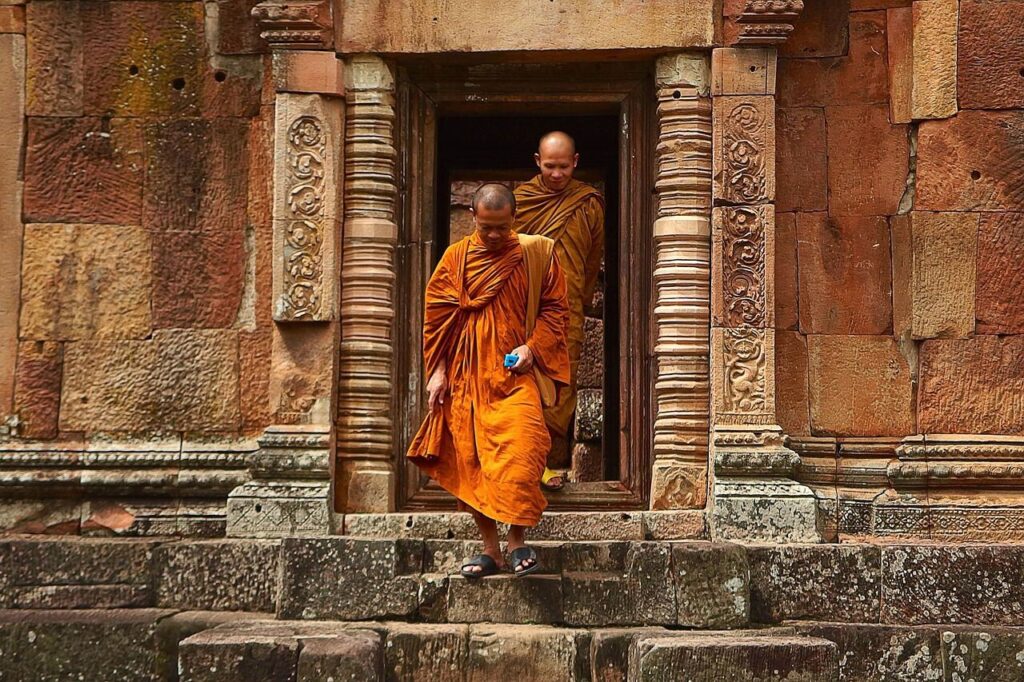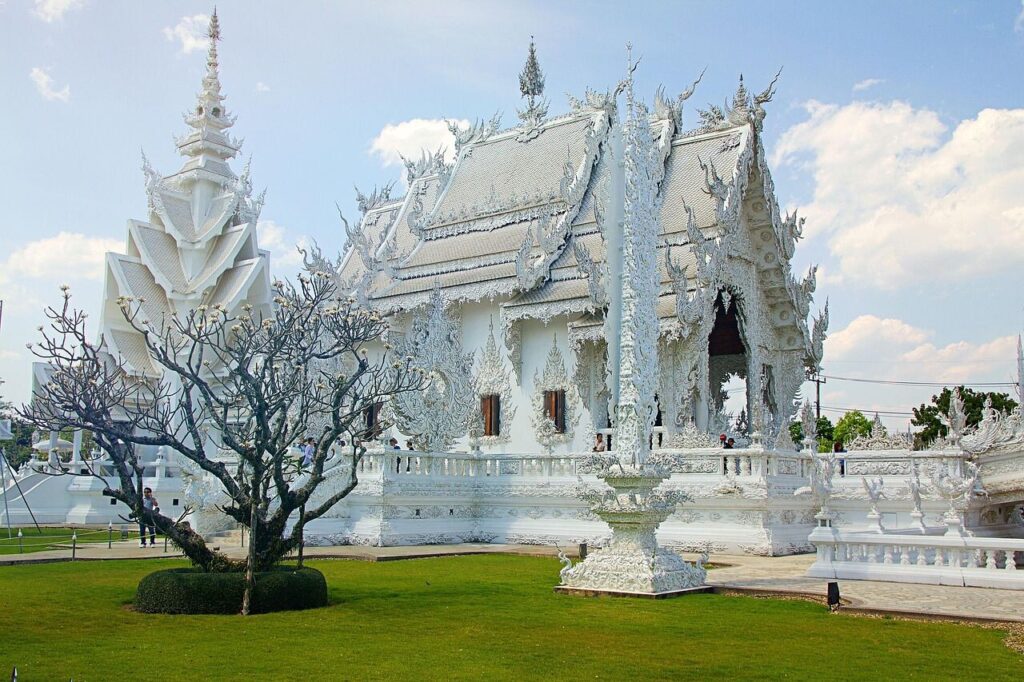Thailand is a destination visited by thousands and thousands of people annually, chosen by many for the variety of experiences it offers: whether you seek to learn about its culture, be left speechless by its landscapes, relax on a paradise beach, or engage in countless activities.
At Cooperating Volunteers, we offer the opportunity to experience international volunteering there. Our projects are located in Trat, a region near the Cambodian border in an extremely rural area, providing a completely different perspective of Thailand—one that few get to experience.
Without a doubt, during your free time or if you decide to extend your stay to explore the country, you will discover true gems—such as its temples.

Did you know that Thailand has more than 40,000 Buddhist temples (wats)?
Of these, around 30,000 are still active with resident monks. Visiting them is a truly immersive experience.
That’s why today we want to mention some of the most popular ones (if we had to talk about all 40,000, we would need many blog pages) so you can add them to your must-visit list if you travel to this country.
THE 10 MOST POPULAR
– WAT PHRA KAEW (Temple of the Emerald Buddha) – Bangkok
It is the most sacred and revered Buddhist temple in Thailand. Located within the Grand Palace of Bangkok, it is famous for housing the Emerald Buddha, a jade statue of great spiritual importance.
Built in 1782 by order of King Rama I, the founder of the Chakri dynasty, it has since been a key site for royal ceremonies and religious festivities. The Emerald Buddha has a fascinating history, as it is said to have been discovered in Chiang Rai in the 15th century and traveled through different cities before arriving in Bangkok.
Carved from jade, it measures only 66 cm in height. Its attire is changed three times a year (summer, winter, and rainy season) in a ceremony performed by the king. The temple’s architecture features golden details, murals depicting scenes from the Ramakien (the Thai epic), and giant guardian Yakshas. Unlike other temples, it has no resident monks.
There are specific rules for visiting: revealing clothing such as shorts or sleeveless shirts is not allowed, and photos are prohibited inside the Emerald Buddha’s sanctuary.
It is one of the most impressive places in Thailand and a must-visit in Bangkok.
– WAT ARUN (Temple of Dawn) – Bangkok
Known as the Temple of Dawn, it is one of Bangkok’s most iconic temples. Its impressive 82-meter central prang (tower), decorated with porcelain and seashells, shines spectacularly in the sunlight, especially at dawn and dusk.
Believed to have been built in the 17th century during the Ayutthaya Kingdom, it was originally called Wat Makok and later renamed Wat Arun Ratchawararam by King Taksin in the 18th century. The temple briefly housed the Emerald Buddha before it was moved to Wat Phra Kaew. During the reigns of Rama II and Rama III, the temple took its current form with its iconic central tower.
Inspired by Khmer architecture, the 82-meter-high tower is decorated with Chinese porcelain. Visitors can climb part of it via steep stairs for a panoramic view of the Chao Phraya River. The temple also has four smaller prangs representing the four cardinal points, along with Yaksha demon statues and mythological Thai figures. The interior features murals and golden pavilion details.
Appropriate clothing covering shoulders and knees is recommended, and while photos are allowed, respect inside the sanctuary is required.
Located on the banks of the Chao Phraya River, opposite Wat Pho, it becomes especially beautiful at sunset.
– WAT PHO (Temple of the Reclining Buddha) – Bangkok
One of Bangkok’s most important and oldest temples, it is famous for housing the gigantic Reclining Buddha, one of Thailand’s most impressive statues. Additionally, it is the birthplace of traditional Thai massage and an important center for Buddhist learning.
Built in the 17th century before Bangkok became the capital, it was renovated by King Rama I in the 18th century, transforming it into a center for Buddhist education. During Rama III’s reign, inscriptions on traditional medicine and Thai massage were added, making it Thailand’s first university.
The Reclining Buddha is 46 meters long and 15 meters high, depicting Buddha entering Nirvana. Its feet (3 meters high) are decorated with mother-of-pearl, displaying 108 auspicious symbols.
The temple complex contains more than 1,000 Buddha images—the largest collection in Thailand—and features 91 stupas decorated with ceramics and flowers.
The massage center is considered the birthplace of traditional Thai massage, where visitors can take classes or receive a massage inside the temple.
Visitors must cover their shoulders and knees. While photos are allowed, touching the Buddha is strictly forbidden.
You’ll find it near the Grand Palace and Wat Arun in central Bangkok.
– WAT PHRA THAT DOI SUTHEP (The Golden Temple) – Chiang Mai
The most sacred and iconic temple in Chiang Mai, it is located atop Doi Suthep Mountain, offering breathtaking panoramic views of the city. Its golden stupa shines brilliantly in the sunlight.
Founded in 1383 during the Lanna Kingdom, legend has it that a monk found a sacred Buddha relic, and the king ordered it to be placed on the back of a white elephant. The elephant climbed the mountain, circled the summit three times, and then passed away at that spot, which was interpreted as a sign to build the temple there.
The golden stupa is the temple’s central sculpture, covered in gold leaf and housing sacred Buddha relics. It is accessed via 309 steps flanked by impressive Naga serpent statues or by a funicular.
The shrines and pagodas are filled with Buddha images in various styles, and there are sacred bells that visitors can ring for good luck.
As in most temples, shoulders and knees must be covered, and neither the stupa nor the Buddha should be touched or disrespected when taking photos.
– WAT RONG KHUN (White Temple) – Chiang Rai
Known as the White Temple, it is one of the most impressive and surreal temples in Thailand. Its unique architecture and bright white color symbolize purity and Buddhist enlightenment.
Designed by Thai artist Chalermchai Kositpipat in 1997, unlike traditional temples, Wat Rong Khun is a contemporary work of art featuring Buddhist elements and modern references. Still under construction, the complete project is expected to include up to nine buildings.
Beyond its distinctive white color, the temple is decorated with mirrors that reflect sunlight. A central bridge, called the ‘Bridge of Reincarnation,’ leads to the temple and is surrounded by sculpted hands symbolizing human desire and suffering.
The entrance to heaven is guarded by two figures representing Death and Rahu, the guardians of the cycle of life. Inside the Ubosot (main hall), murals unexpectedly depict modern characters like Neo from *The Matrix*, Superman, and even Darth Vader as symbols of ego and distraction in life.
A golden house, surprisingly, serves as the temple’s restroom.
Visitors must cover their shoulders and knees, and photography inside the main building is not allowed.

– WAT PHRA SI SANPHET (The Royal Temple) – Ayutthaya
One of the most important temples in the ancient capital of Thailand, Ayutthaya. Famous for its three iconic stupas, it was the royal temple and served as a model for Wat Phra Kaew in Bangkok.
Built in 1350 as part of the Grand Palace of Ayutthaya, it became a royal temple in 1491 under the reign of King Ramathibodi II. It had no resident monks, as it was exclusively for the royal family. It was destroyed in 1767 by the Burmese army when they sacked Ayutthaya.
The three central stupas contain the ashes of Kings Ramathibodi II, Borommatrailokanat, and Borommaracha III. They are the most recognized symbol of Ayutthaya. There are also ruins of ceremonial halls and ancient chapels. The temple once housed a 16-meter-tall Buddha statue covered in gold, which was melted down and looted by the Burmese.
Visitors are advised to wear clothing that covers shoulders and knees. Climbing on the ruins is not allowed, and sacred areas must be respected.
Located in Ayutthaya Historical Park, 80 km from Bangkok.
– WAT MAHATHAT – Ayutthaya
One of the most famous temples in the ancient city of Ayutthaya, known for the Buddha head entwined in tree roots.
Built in the 14th century, it was an important royal and religious center during the Ayutthaya Kingdom. It was destroyed in 1767 by the Burmese invasion and is now a historical site.
The temple’s most iconic feature is the stone Buddha head wrapped in the roots of a Bodhi tree. There are also numerous Buddha statues, stupas, and ruins of ancient structures.
Since it is a sacred site, visitors should not sit or stand above the Buddha’s head for photos. Proper dress is required.
It is located in Ayutthaya Historical Park, about an hour from Bangkok.
– WAT SUTHAT – Bangkok
The Temple of the Great Buddha and the Giant Swing is one of the most impressive yet less touristy temples in Bangkok. It is famous for its Great Bronze Buddha, exquisite murals, and the Giant Swing (Sao Ching Cha) located at its entrance.
It was built in 1807 during the reign of King Rama I and completed by Rama III. It is one of the first-class royal temples, meaning it holds great importance for the monarchy. In its early days, the Giant Swing was used in Brahmin ceremonies, but its use was later banned for safety reasons.
The Great Bronze Buddha (Phra Sri Sakyamuni) is 8 meters tall and was brought from Sukhothai.
The temple is filled with impressive murals covering all its interior walls, depicting the Ramakien (the Thai version of the Ramayana). The Giant Swing stands 21 meters tall and is made of red teakwood. It was used in religious ceremonies to symbolize the quest for divine happiness.
Photography is allowed, but visitors must be respectful inside the sanctuary. Shoulders and knees must be covered.
Located in the Giant Swing Square, near the Grand Palace and Wat Pho.
– WAT SAKET (Temple of the Golden Mount) – Bangkok
Located on a man-made hill, it offers one of the best panoramic views of Bangkok. It is famous for its golden stupa and an annual religious festival.
Its construction dates back to the Ayutthaya period, but it was renovated by King Rama I and later modified by King Rama III, who attempted to build a large chedi (stupa) that collapsed due to the soft ground. King Rama IV reinforced it, and Rama V completed the Golden Mount, which today is one of the city’s most famous landmarks.
The temple’s main attraction is its 79-meter-high golden chedi, which houses a relic of the Buddha. The ascent involves climbing around 300 steps, surrounded by lush vegetation, bells, and statues. At the top, visitors can enjoy a spectacular 360-degree view of Bangkok.
Every November, a famous temple fair is held, attracting thousands of people who light candles and offer prayers.
Visitors are advised to wear appropriate clothing. Photos can be taken, but silence and respect should be maintained, especially at the top.
Located near the Old City, it is an excellent place to visit at sunset.
– WAT PA PHU KAN (Temple of Peace in the Mountain) – Udon Thani
This is a unique Buddhist temple in Thailand, located in a mountainous area surrounded by nature. It is a place of meditation and tranquility, far from the tourist crowds, famous for its impressive reclining Buddha statue made of white marble.
Built between 2010 and 2013 as a meditation and spiritual retreat center, its architecture blends traditional Thai style with modern design. It is situated in a protected forest, making it a perfect place for contemplation.
The White Marble Reclining Buddha is 20 meters long and made from Italian Carrara marble. It represents Buddha in the state of Parinirvana, symbolizing absolute peace.
The blue roof with golden details symbolizes the sky and spiritual enlightenment, while the columns are carved with lotus leaves and flowers.
Visitors should wear modest clothing that covers shoulders and knees, maintain silence, and show respect, as it is a place for meditation.

These are just 10 of the many temples you can visit if you travel to Thailand for your volunteer experience.
Each one is unique and special, filled with intricate details that reflect the care, importance, and dedication given to their construction.
If you travel to Thailand, you cannot miss them.




